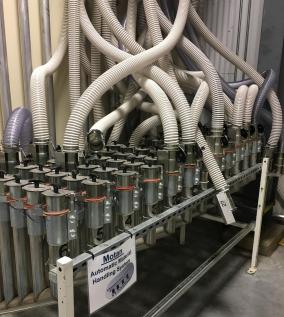Suppose you are new to manufacturing an injection-molded product (using plastic or other materials). In that case, it is critical to realize the impact material selection for injection molding has on designing and manufacturing a product.
Case in point: Recently, a company that sells outdoor/sporting equipment contacted us to ask if we could take an aluminum part used in one of their products and manufacture it in plastic. The company’s goal was to reduce the cost of their existing part.

Our engineering department uses Finite Element Analysis software to help develop solutions to these kinds of challenges. This software allows us to address very complicated problems by dividing them into small elements that can be solved in relation to one another. In this particular case, FEA (Finite Element Analysis) enabled our engineer to optimize the molded part’s design with as much stiffness as possible per material used. The analysis presented a comparison of the molded part design to the aluminum part, making it possible to select the proper material and show how the molded part’s strength would theoretically compare to the existing one.
In other cases, we have been able to help a customer save money. For example, not long ago, a customer asked us to use a high-end material for a product – 50% carbon fiber-filled nylon with Teflon® – but we had concerns about filling the part, achieving a uniform surface appearance, and cost to produce. Our engineers, working in conjunction with our materials suppliers, were able to suggest a 30% glass-filled nylon, which cost about 20% of the original high-end material we were asked to use at the start. Also, the material we recommended lent itself to better cosmetics and even outperformed the high-end material in the customer’s drop testing.
Why does material selection matter?
Proper material selection for injection molding will protect you from costly tooling adjustments once production has begun. Because injection molds are built for a specific shrinkage, making the right material selection is crucial for any successful injection molding project. There are several factors to consider when it comes to selecting the proper materials. We will mention those later.
If the mold was not designed with proper material selection, it could become costly for the customer down the road, when modifications are needed. Also, if experienced engineers do not appropriately advise the customer, it could be a missed opportunity from using improved material that might help optimize the quality and function of the product.
Additionally, selecting the right material upfront can save you time, allowing your product to be market-ready faster.

Software
Besides using Finite Element Analysis, as mentioned before, our engineers at HTI Plastics also use Solidworks Plastics mold flow simulation software. Solidworks help us determine if we can produce a given part design in a specific material.
There are cases where the chosen material is not suitable for the part design, and it is ideal to figure that out early on in the process. It also helps us point out potential concerns based on the material selected – some materials have poor weld line strength or are more prone to warpage. Proper material selection allows us to consider those possibilities upfront.
Converting Products into Plastics Parts
To convert from one material to another, we use Finite Element Analysis. If we have two designs and known material properties, we can directly compare properties to determine if the alternative material will perform satisfactorily.
What factors need to be considered?
Many factors have to be considered when selecting materials for an injection-molded product to ensure optimum performance.
- Part size, thickness, aesthetics, color, living hinge
- Cost
- Mechanical properties: stiffness, tensile strength, impact strength, fatigue resistance
- Electrical insulation
- Thermal properties
- Welding/bonding
- Chemical resistance
- FDA compliance
- High Volume Parts
- Transparency of the material
- UV exposure
- Sterilization requirements
- Service life
- Over-molding
- Surface finish
- UL Certification

HTI Engineers Material Selection Process
Our engineers start by considering all of the factors previously mentioned. After checking all the factors, they move on to looking at the lowest cost materials that meet requirements, but we also have to consider the logistics such as availability of the material, order quantities, lead time, etc. We also have access to great technical resources from our material suppliers, so we often check with them to make sure we are giving the most up-to-date material suggestions and information, since the industry is constantly evolving.
Most popular Injection Molding Materials and why
At HTI Plastics, the most popular materials are Polyethylene, Polypropylene, and Nylon. With materials (as with most things) the better properties come with a higher cost. Polyethylene is on the low end of cost and properties, but it provides a good mix of mechanical properties, chemical resistance, barrier properties, and processibility that is very attractive for single use products and also some durable products. Polypropylene is similar to Polyethylene but slightly higher in performance – we gain some stiffness, it works well with glass filler for even higher stiffness, and it works great for living hinges. Polyethylene and Polypropylene are considered commodity resins because they are inexpensive and produced in massive volumes. Moving up to higher performance you get into engineering grades of resin such as Nylon. Nylon further increases stiffness (especially with glass filler) and high temperature performance so it is suitable to be used in places where PE or PP would be near their melting points. There are hundreds if not thousands of grades of each of these materials so there are many different options to tailor each one to a customer’s needs.
Medical Grade Resins Selections
Food grade and over the counter manufactured pharmaceutical products generally need to meet FDA CFR Title 21 regulation for food contact surfaces. Many of our products are produced with FDA materials using GMP procedures to provide parts that are safe for food contact and storage or dispensing of pharmaceutical products.
Regulatory Consideration
We expect customers to be aware of any regulations that affect their products. We have customers that are subject to FDA, UL, ATF, NHTSA, and FAA regulations.
Minimize Supply Chain Risks
We can work with customers to qualify alternate materials if there are supply chain issues with a given grade of resin. In many cases, multiple manufacturers supply similar resin, so choosing an alternate can be easy. Generally, we will try to avoid using materials exposed to low supply risk because there are times where feedstock or facility issues cause shortages of different materials.
By Tyler Williams, Mechanical Engineer at HTI Plastics
If you have additional questions about material selection, our engineering services, or any of the other HTI Plastics service, please contact us through our website www.htiplastic.com, or at 1-800-824-0607.

